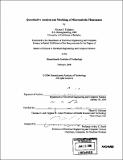Quantitative analysis and modeling of microembolic phenomena
Author(s)
Feldstein, Michael J. (Michael Jordan)
DownloadFull printable version (17.80Mb)
Other Contributors
Massachusetts Institute of Technology. Dept. of Electrical Engineering and Computer Science.
Advisor
Elazer R. Edelman.
Terms of use
Metadata
Show full item recordAbstract
This thesis explores parameters that govern microvascular occlusion secondary to embolic phenomenon. Bulk and individual properties of microembolic particles were characterized using light microscopy, SEM and optically-based particle analysis. Particulate probability distributions were created from imaging data using Matlab. Size distribution, volume, morphology and chemical properties were quantified using in-vivo and model flow systems to correlate particulate characteristics and occlusive efficacy. This study focused on novel expandable/deformable Polyacrylic acid microspheres (PAA-MS) for use as catheter-deliverable therapeutic emboli. These emboli expand in aqueous media such as blood and remain unexpanded in custom delivery media. The techniques developed to investigate therapeutic microemboli were applied to the analysis of clot dissolution byproducts. PAA-MS expand volumetrically in seconds when placed in aqueous environments. PAA-MS were modified to resist fragmentation based upon failure analysis. Degradation testing demonstrated PAA-MS chemical stability. Charge characteristics inherent to the PAA-MS acid matrix were leveraged to develop low-viscosity media that prevent expansion. Cationic dyes were found that bind the charged matrix within PAA-MS to enhance visualization. (cont.) Unexpanded PAA-MS were delivered through standard catheters and microcatheters at concentrations that induce durable occlusions. Non-expandable microspheres could not be delivered through microcatheters. PAA-MS required less embolic mass to occlude in-vitro flow systems at significantly higher pressures than nonexpandable microspheres. Preliminary biocompatibility tests demonstrated safety and PAA-MS were able to occlude both porcine renal and coronary vasculature in-vivo. An ultrasonic clot dissolution device generated microemboli from synthetic acellular fibrin-only clots and whole blood clots. The average particle size for whole blood clots was less than 100 microns and acellular clots produced larger average emboli than whole blood clots, indicating that cellular components may limit thromboembolic size. The expandable/deformable properties of PAA-MS allow them to traverse microcatheters when unexpanded. Once in blood, PAA-MS expand 140-fold to create a space-filling, pressure resistant occlusion. (cont.) These results have implications for intravascular embolization procedures where smaller catheters minimize vasospasm and allow more precise targeting while stronger occlusions resist occlusive breakdown and associated distal embolization. These embolic improvements could reduce procedural complications while increasing efficacy. Future work will solidify correlations between microembolic properties, microvascular occlusion and tissue infarction.
Description
Thesis (S.M.)--Massachusetts Institute of Technology, Dept. of Electrical Engineering and Computer Science, 2006. Includes bibliographical references (p. 131-136).
Date issued
2006Department
Massachusetts Institute of Technology. Department of Electrical Engineering and Computer SciencePublisher
Massachusetts Institute of Technology
Keywords
Electrical Engineering and Computer Science.